Modellers Shipyard
| Naam | Omschrijving | Afbeelding |
|---|---|---|
| SHACKLETON’S JAMES CAIRD | The Shackleton’s James Caird Model Boat Kit is manufactured by Modellers Shipyard. Modellers Shipyard offer historically accurate Wooden Model Ship Kits and Wooden Model Boat kits which are faithful interpretations of the original vessels. The comprehensive instructional DVDs, plans and highly detailed English instructions will assist you throughout the whole construction process. Modeller’s Shipyard is proud to present another wooden model ship in our range of kits that have significance to maritime history. Our model of Shackleton’s James Caird is expertly designed and built by John Staib – master model ship designer and builder. The kit is double planked and comes with highly detailed English written building instructions with extensive color photos showing every step on the model ship kit’s construction. Modellers Shipyard only use the highest quality parts and fittings. History of the Shackleton’s James Caird The voyage of the James Caird was a journey of 1,300 kilometres (800 mi) from Elephant Island in the South Shetland Islands through the Southern Ocean to South Georgia, undertaken by Sir Ernest Shackleton and five companions to obtain rescue for the main body of the stranded Imperial Trans-Antarctic Expedition of 1914–1917. Polar historians regard the voyage of the crew in a 22.5-foot (6.9 m) lifeboat through the “Furious Fifties” as one of the greatest small-boat journeys ever completed. In October 1915, pack ice in the Weddell Sea had sunk the main expedition ship Endurance, leaving Shackleton and his 27 companions adrift on a floe. They drifted northward until April 1916, when the floe on which they were camped broke up, then made their way in the ship’s lifeboats to Elephant Island. The rigours of an Antarctic winter were fast approaching; the narrow shingle beach where they were camped was already being swept by almost continuous gales and blizzards, which destroyed one of the tents in their temporary camp, and knocked others flat. The pressures and hardships of the previous months were beginning to tell on the men, many of whom were in a run-down state both mentally and physically. In these conditions, Shackleton decided to try to reach help, using one of the boats. The nearest port was Stanley in the Falkland Islands, 570 nautical miles (1,100 km; 660 mi) away, but made unreachable by the prevailing westerly winds. A better option was to head for Deception Island, 200 nautical miles (370 km; 230 mi) away at the western end of the South Shetland chain. Although it was uninhabited, Admiralty records indicated that this island held stores for shipwrecked mariners, and was also visited from time to time by whalers. However, reaching it would also involve a journey against the prevailing winds – though in less open seas – with ultimately no certainty when or if rescue would arrive. After discussions with the expedition’s second-in-command, Frank Wild, and ship’s captain Frank Worsley, Shackleton decided to attempt to reach the whaling stations of South Georgia, to the north-east. This would mean a longer boat journey of 700 nautical miles (1,300 km; 810 mi) across the Southern Ocean, in conditions of rapidly approaching winter, but with the help of following winds it appeared feasible. Shackleton thought that “a boat party might make the voyage and be back with relief within a month, provided that the sea was clear of ice, and the boat survive the great sea. Shackleton’s first choices for the boat’s crew were Worsley and Tom Crean, Shackleton was confident that Crean would persevere to the bitter end, and he had great faith in Worsley’s skills as a navigator, especially his ability to work out positions in difficult circumstances. Worsley later wrote: “We knew it would be the hardest thing we had ever undertaken, for the Antarctic winter had set in, and we were about to cross one of the worst seas in the world”. Shackleton requested volunteers for the remaining places. Many came forward – he chose two strong sailors in John Vincent and Timothy McCarthy. He offered the final place to the carpenter, McNish. “He was over fifty years of age”, wrote Shackleton of McNish (he was in fact 41), “but he had a good knowledge of sailing boats and was very quick”. Vincent and McNish had each proved their worth during the difficult boat journey from the ice to Elephant Island. The South Georgia boat party could expect to meet hurricane-force winds and waves – the notorious Cape Horn Rollers – measuring from trough to crest as much as 18 m (60 ft). Shackleton therefore selected the heaviest and strongest of the three boats, the 22.5-foot (6.9 m) long James Caird. It had been built as a whaleboat in London to Worsley’s orders, designed on the “double-ended” principle pioneered by Norwegian shipbuilder Colin Archer. Shackleton had named it after Sir James Key Caird, a Dundee philanthropist whose sponsorship had helped finance the expedition. Knowing that a heavily-laden open sea voyage was now unavoidable, Shackleton had already asked the expedition’s carpenter, Harry McNish to modify the boats during the weeks the expedition spent at Patience Camp. Using material taken from Endurance’s fourth boat, a small motor launch which had been broken up with this purpose in mind before the ship’s final loss, McNish had raised the sides of the James Caird and the Dudley Docker by 8–10 inches (20–25 cm). Now in the primitive camp on Elephant Island, McNish was again asked if he could make the James Caird more seaworthy. Using improvised tools and materials, McNish built a makeshift deck of wood and canvas, sealing his work with oil paints, lamp wick, and seal blood. The craft was strengthened by having the mast of the Dudley Docker lashed inside, along the length of her keel. She was then fitted as a ketch, with her own mainmast and a mizzenmast made by cutting down the mainmast from the Stancomb-Wills, rigged to carry lug sails and a jib. The weight of the boat was increased by the addition of approximately 1 long ton (1 tonne) of ballast, to lessen the risk of capsizing in the high seas that Shackleton knew they would encounter. Worsley believed that too much extra ballast (formed from rocks, stones and shingle taken from the beach) was added, making the boat excessively heavy, giving an extremely uncomfortable ‘stiff’ motion and hampering the performance for sailing upwind or into the weather. However he acknowledged that Shackleton’s biggest concern was preventing the boat capsizing during the open-ocean crossing. The boat was loaded with provisions to last six men one month; as Shackleton later wrote, “if we did not make South Georgia in that time we were sure to go under”. They took ration packs that had been intended for the transcontinental crossing, biscuits, Bovril, sugar and dried milk. They also took two 18-gallon (68-litre) casks of water (one of which was damaged during the loading and let in sea water), two Primus stoves, paraffin, oil, candles, sleeping bags and odd items of spare clothing. After surviving a series of dangers, including a near capsizing, the boat reached the southern coast of South Georgia after a 17-day voyage. Shackleton, Tom Crean and Frank Worsley crossed the island’s mountains to a whaling station on the north side. Here they organised the relief of the three men left on the south side of the island and of the Elephant Island party. Ultimately, the Endurance crew returned home without loss of life. After the First World War, in 1919, the James Caird was moved from South Georgia to England. It has been on regular display at Shackleton’s old school, Dulwich College, since 1922. Scale 1 to 20 Length 13.5" (345mm) Height 9.8" (250mm) Width 4.3" (110mm) |  |
| ISABELLA – Paddle Steamer 1912 | The Isabella Paddle Steamer 1912 Model Boat Kit is manufactured by Modellers Shipyard offer historically accurate ship model kits which are faithful interpretations of the original vessels. All kits have highly detailed English building instructions which will guide you throughout the whole construction process. All ship model kits are double plank on bulkhead construction and only use the highest quality parts. Most kits have an optional extra DVD set demonstrating techniques to build the relevant kit. The kit is plank on bulkhead construction with laser cut board. This ship model kit comes complete with all timber, rigging cord, and wooden and metal fittings. All parts and fittings are of the highest quality. It Includes 12 sheets of detailed instructions with extensive colour photographs. History of the Isabella Paddle Steamer 1912 Paddle steamers and riverboats formed a vital part in opening up the inland of Australia. The inland river system of the Murray, Darling, Lachlan and Murrumbidgee formed a network to connect inland communities across the Australian states of New South Wales, Victoria, Queensland and South Australia. Paddle steamers have been plying these inland waters since 1853 travelling along the river system from Goolwa at the mouth of the Murray to the inland towns of Bourke on the Darling, Wagga Wagga on the Murrumbidgee and Forbes on the Lachlan. Paddle steamers opened up the inland of eastern Australia allowing goods such as wool and wheat to be transported along the rivers to the inland ports of Echuca and Goolwa and then for transfer to the sea ports of Port Elliot, Adelaide or Melbourne. These same paddle steamers then transported cargo needed for these growing inland communities. Life on the rivers was hard for the owners, crew and often families on the paddle steamers. Droughts often stranded the boats for months on end. Floods brought their own hazards with fast flowing waters, poorly defined river banks and submerged tree snags made navigation difficult and often dangerous. The Isabella Paddle steamer 1912 is typical of the working boats that plied the river system in the late 1800s to the early 1900s. Working boats like her towed cargo barges up and down the rivers, servicing the needs and providing vital links for the inland communities to the outside world. Length 16-1/2" (420mm) Height 6" (150mm) Scale 1 to 60 | 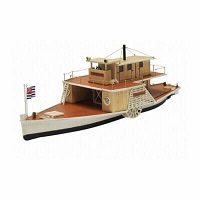 |
| Mary Byrne Admiralty 1826 Model | The Mary Byrne Admiralty Model Ship Kit is manufactured by Modellers Shipyard is highly detailed and intricate and will appeal to the model builder looking for a challenging and interesting model to build. Modellers Shipyard Admiralty model of the colonial ketch Mary Byrne 1926, is a unique and original model. The Admiralty model kit of the Mary Byrne 1826 is expertly designed and built by John Staib – master model ship designer and builder. As with all new release model ship kits from Modellers Shipyard the frames of the kit have laser scored fairing lines that ensure the fairing of the frames is easy, accurate and symmetrical – this feature is unique to Modellers Shipyard designed kits The kit comes complete with quality fittings, clean and accurate laser cut parts and highly detailed English written building instructions with color photos of every step of the kit’s construction. History of the Mary Byrne Admiralty Admiralty models were an English invention of the 17th century, when the British Admiralty required a model as well as the plans of each new type of ship. The characteristic feature of Admiralty models was the underwater hull, which was built as a frame model. The part above the waterline was fully planked – this characteristic feature shows the construction of the hull frames and deck beams along with all supports. Scale 1 to 48 Length 380 (15") Height 140mm (5.5") Width 120mm (4.72") | 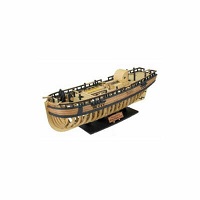 |
| Port Jackson Schooner 1803 | The Port Jackson 1803 Model Ship Kit Starters Pack is manufactured by Modellers Shipyard. Modellers Shipyard offer historically accurate Wooden Model Ship Kits and Wooden Model Boat kits which are faithful interpretations of the original vessels. The comprehensive instructional DVDs, plans and highly detailed English instructions will assist you throughout the whole construction process. All ship model kits are double plank on bulkhead construction and only use the highest quality parts. History of the Port Jackson Schooner Port Jackson Schooner – In September 1788, only 18 months after the founding of the new colony on the shores of Port Jackson – now better known as Sydney Harbour, Governor Arthur Phillip sent a message to his superiors in England requesting two vessels to be sent out in frame, with a few shipwrights to put them together. After considerable delay, drafts were prepared for a ‘Schooner for Port Jackson’. The original drafts are still in the National Maritime Museum, Greenwich, England and are the raw material on which our drawings and kit of the ‘Colonial Schooner Port Jackson’ are based. We have no records available to show whether in fact our schooner was actually constructed or if so what become of her, however, our model is in every way an accurate representation of an early Australian colonial schooner as constructed by the infant industry that emerged during the 15 years waiting for a completed response to Governor Arthur Phillip’s original request. A drawing of the ‘Mercury’ owned by Mary Reiby an early Sydney merchant appears on the Australian $20 currency note. The ‘Mercury’ is identical to the ‘Port Jackson-Schooner’. Scale 1 to 50 Length 23" (590mm) Height 17-1/2" (450mm) | 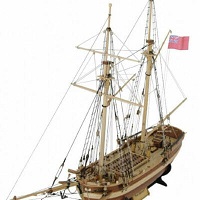 |
| MV Krait | The MV Krait Model Boat Kit is manufactured by Modellers Shipyard. The MV Krait Model Boat Kit is expertly designed and highly detailed. Laser cut plywood is clean and accurate. Construction is double plank on bulkhead and all parts and fittings are of the best quality. The building instructions comprise 109 pages of highly detailed written instructions with colour photos and drawings showing every step of the construction. A unique feature of this kit is that it has fairing laser score lines on the bulkheads to make the fairing accurate and symmetrical. View the complete instructions here – M. V. Krait Instructions History of the MV Krait Built in 1934 in Japan and originally named Kofuku Maru (Happiness or Good Fortune), Krait collected fish from fishermen and ports around the Rhio Archipelago and took the catch to the Singapore markets. It took food, water and other supplies to the fishing fleet. Confined to port early in World War II, the boat was used by Captain Bill Reynolds to evacuate hundreds of civilians to nearby Sumatra and when the Japanese continued to advance he took it to Colombo. It was soon proposed that the vessel be used as part of a covert operation. Renamed Krait (after a deadly species of snake) its most famous hour came in 1943 when a 14-strong company of British and Australian army and naval personnel set out on a daring commando night raid on shipping in the Singapore Roads. At dawn on 27 September 1943, Singapore Harbour shook to violent explosions. “Operation Jaywick” had attacked the heart of Japanese-occupied Singapore. The raiders, mostly RAN volunteers, were led by a British officer, Major Ivan Lyon. They had travelled over 4,500 kilometres through Japanese-held islands in a rickety-looking fishing boat, Krait. Codenamed Operation , Jaywick, Krait was disguised as a Japanese fishing boat and successfully sailed to within striking distance of Singapore. Six operatives then deployed three two-man folding canoes to island hop over three nights and finally reach Singapore Harbour where they attached magnetic limpet mines to the hulls of Japanese merchant vessels. Six of the mines exploded damaging some 37,000 tonnes of shipping. The operation destroyed or badly damaged seven Japanese ships. Krait then operated out of Darwin as a coastwatch and intelligence support vessel in Indonesia. Commissioned HMAS Krait in 1944, the vessel witnessed the Japanese surrender at Ambon in September 1945 and after the war was handed to the British Borneo Civil Affairs Unit. The MV Krait played a significant role in Australian WW2 military history. Scale 1 to 35 Length 610mm Height 290mm |  |
| Colonial Brig Perseverance 1807 | The Colonial Brig Perseverance 1807 Starters Pack is manufactured by Modellers Shipyard. Modellers Shipyard offer historically accurate Wooden Model Ship Kits and Wooden Model Boat kits which are faithful interpretations of the original vessels. The comprehensive instructional DVDs, plans and highly detailed English instructions will assist you throughout the whole construction process. All ship model kits are double plank on bulkhead construction and only use the highest quality parts. History of the Colonial Brig Perseverance The Colonial Brig Perseverance was owned by Robert Campbell, a noted Sydney merchant of the time. Campbell launched his first ship the Perseverance, a 136 ton brig, at the site of Australia’s first shipbuilding yards in 1807. In 1810, the Perseverance was fitted out for a trip to the southern oceans on which the ships Captain Frederick Hasselborough discovered two new sealing grounds, Campbell Island which he named after his employer, and Macquaire Island, named after the Governor of New South Wales at the time. Sadly on his return voyage to Campbell Island, Captain Hasselborough, drowned when his jollyboat capsized in Perseverance Harbour, Campbell Island, 4th November 1810. The last voyage of the Perseverance began on the 7th September 1828, when she departed Sydney headed to New Zealand. In October 1828 she was wrecked on Campbell Island. The Perseverance, was employed in the Southern New Zealand trade the whole of her career, with the exception of a short period when used as a hulk at Sydney. A double plank on bulkhead construction with laser cut plywood. This ship model kit comes complete with all timber, rigging cord, and wooden and metal fittings. All parts and fittings are of the highest quality. It Includes a detailed instructions with photographs and diagrams, and construction plans. Scale 1 to 48 Length 34-1/2" (880mm) Height 29" (740mm) |  |
| Colonial Schooner Port Jackson 1803 | A double plank on bulkhead construction with laser cut plywood. The Port Jackson Schooner model ship kit comes complete with all timber, rigging cord, and wooden and metal fittings. All parts and fittings are of the highest quality. It Includes 32 pages of detailed instructions with color photos and diagrams. WE ALSO RECOMMEND: The four hour 2 DVD set on ‘The Complete Guide on: How to Build the Schooner Port Jackson’. This DVD set takes the modeller through planking the hull and deck, building the deck furniture and completing the rigging. Many tips and techniques of building a period wooden model ships are presented. Modellers Shipyard offer historically accurate Wooden Model Ship Kits and Wooden Model Boat kits which are faithful interpretations of the original vessels. The comprehensive instructional DVDs, plans and highly detailed English instructions will assist you throughout the whole construction process. All ship model kits are double plank on bulkhead construction and only use the highest quality parts. History of the Port Jackson Schooner In September 1788, only 18 months after the founding of the new colony on the shores of Port Jackson – now better known as Sydney Harbour, Governor Arthur Phillip sent a message to his superiors in England requesting two vessels to be sent out in frame, with a few shipwrights to put them together. After considerable delay, drafts were prepared for a ‘Schooner for Port Jackson’. The original drafts are still in the National Maritime Museum, Greenwich, England and are the raw material on which our drawings and kit of the ‘Colonial Schooner Port Jackson’ are based. We have no records available to show whether in fact our schooner was actually constructed or if so what become of her, however, our model is in every way an accurate representation of an early Australian colonial schooner as constructed by the infant industry that emerged during the 15 years waiting for a completed response to Governor Arthur Phillip’s original request. A drawing of the ‘Mercury’ owned by Mary Reiby an early Sydney merchant appears on the Australian $20 currency note. The ‘Mercury’ is identical to the ‘Port Jackson-Schooner’. Scale 1 to 50 Length 23" (590mm) Height 17.5" (450mm) |  |
| HMA Submarine AE1 /AE2 | The HMA Submarine AE1/AE2 Model Kit is manufactured by Modellers Shipyard. Modellers Shipyard offer historically accurate Wooden Model Ship Kits and Wooden Model Boat kits which are faithful interpretations of the original vessels. The comprehensive instructional DVDs, plans and highly detailed English instructions will assist you throughout the whole construction process. All ship model kits are double plank on bulkhead construction and only use the highest quality parts. The HMA Submarine AE1/AE2 model kit of the AE Class submarine is unique in its construction being plank on bulkhead rather than a preformed resin or plastic hull. The kit comes complete with all parts and fittings, limewood planking and laser cut keel and bulkheads as well as highly detailed written building instructions with large colour photos. The HMA Submarine AE1/AE2 Model kit comes with two name plates so the model can be presented as either the AE1 or AE2. This is a unique and important model to Australian naval and maritime history. History of the HMA AE1/AE2 Submarine HMAS AE1 & AE2 (originally known as AE1 & AE2) were an E-class submarine of the Royal Australian Navy (RAN). The two submarines were ordered for the fledgling navy and were built by Vickers Armstrong in England and commissioned into the RAN in 1913. Both submarines then sailed to Australia in what was, at the time, the longest voyage ever undertaken by a submarine. After the start of World War I, AE1 & AE2 were sent to German New Guinea with the Australian Naval and Military Expeditionary Force. Both boats took part in the operations leading to the occupation of the German territory, including the surrender of Rabaul on 13 September 1914. The AE1 departed Blanche Bay, Rabaul 07:00 on 14 September, to patrol off Cape Gazelle with HMAS Parramatta. When she had not returned by 20:00, several ships were dispatched to search for her. No trace of the submarine found and was listed as lost with all 35 hands. It is probable that she was wrecked on a reef or other submerged object. As well as Lieutenant Commander Thomas Besant, 2 other officers and 32 sailors were lost in this disaster. The disappearance was the first major loss for Australia of the World War. In recent years a number of searches have been carried-out to locate the AE1 – all without success. Until in December 2017 the wreck of the AE1 was discovered – a truly historic event in Australian Naval history. The AE2 was assigned to the Dardanelles Campaign in January 1915. At 02:30 on the 25 April 1915 – the day of the Gallipoli Landings – the AE2 successfully penetrated the Narrows of the Dardanelles and entered the Sea of Marmara. With orders to “run amok” inside Turkish territory, AE2 operated for five days before mechanical faults forced her to the surface, where she was damaged by the torpedo boat Sultanhisar. The submarine was scuttled by her crew, all of whom were captured. AE2 was the only RAN vessel lost to enemy action during World War I. The Rahmi M. Ko Museum began searching for the AE2 wreck in 1995, and found it in 1998. After another expedition in 2008, the Australian and Turkish Governments decided to leave the boat in place. The AE2 is the last tangible relic of that conflict. Scale 1 to 90 Length 25" (630mm) Height 10.2" (260mm) | 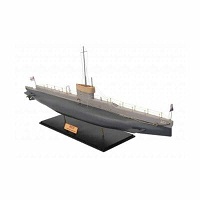 |
| DUYFKEN 1606 | The Duyfken 1606 Model Ship Kit is manufactured by Modellers Shipyard. Modellers Shipyard offer historically accurate Wooden Model Ship Kits and Wooden Model Boat kits which are faithful interpretations of the original vessels. The comprehensive instructional DVDs, plans and highly detailed English instructions will assist you throughout the whole construction process. All ship model kits are double plank on bulkhead construction and only use the highest quality parts. The Duyfken model ship kit comes complete with all parts and fittings, timbers and highly detailed colour building instructions. The laser cutting is excellent and accurate. Double planked with the first layer limewood and second layer tanganika. A unique feature of this kit is that it has fairing laser score lines on the bulkheads to make the fairing accurate and symmetrical. History of the Duyfken 1606 It was during a search for new commercial opportunities in 1606 that a ship owned by the Dutch East India Company made the first recorded European contact with Australia. Captain Willem Janszoon sailed the Duyfken 1606 east of Indonesia to investigate rumours that New Guinea had large deposits of gold. Janszoon sailed along New Guinea’s south coast to the country’s most southwestern point before heading south east. When Janszoon and his crew next saw land, they entered history as the first known Europeans to sight Australia. They anchored at Pennefather River, about 150km south of Cape York, before becoming the first Europeans to walk on Australian soil. Janszoon went on to map over 300km of the Cape York Peninsula’s western coast – the very first section of Australian coastline to be charted. But he never realised that the strange coast he’d stumbled upon was part of a continent unknown to Europeans. This was due to the fact that he had no evidence of the existence of the channel of water that separates New Guinea and Australia (we now call Torres Strait). Looking at the two unfinished coastlines on his map of New Guinea and the western side of Cape York Peninsula, he suggested the two land masses might be connected. Ironically, in the same year as the Duyfken’s expedition, a Spanish ship negotiated the strait from the east. Records made by the ship’s captain, Luis Vaz de Torres, were largely unknown until they were translated by Scottish geographer Alexander Dalrymple in 1769. Despite the best efforts of the Dutch, it would take another century and a half before the unknown south land would be identified as a separate continent by Captain James Cook. Future explorers were to refer to Janzoon’s map and log. But the significance of the Duyfken’s first landing would eventually fade from human memory over the centuries. Fortunately, copies of the original chart were made in the 1670s. One of these became part of a collection of sea charts, sometimes referred to as the ‘secret atlas’ of the Dutch East India Company. Sold to the Vienna Imperial Library in 1737, the collection remained in obscurity for nearly two centuries. It wasn’t until the chart was brought to light and published in 1930 that Australia was provided with significant evidence of its earliest European history. Through their travels, the crew of the Duyfken 1606 also became the first Europeans to encounter Australian Aborigines. It was not to be an auspicious start to relations between the two peoples – a bloody conflict ensued with lives lost on both sides. Scale 1 to 48 Length 18 3/4" (480mm) Height 16 1/2" (420mm) | 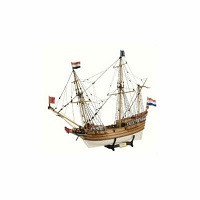 |
| LONGBOAT – HMS Sirius 1786 | The HMS Sirius Longboat 1786 Model Ship Kit is manufactured by Modellers Shipyard. Modellers Shipyard offer historically accurate Wooden Model Ship Kits and Wooden Model Boat kits which are faithful interpretations of the original vessels. The comprehensive instructional DVDs, plans and highly detailed English instructions will assist you throughout the whole construction process. All ship model kits are double plank on bulkhead construction and only use the highest quality parts. History of the HMS Sirius Longboat The LONGBOAT – HMS Sirius 1786 was the flag ship of the First Fleet. Under the command of Captain Arthur Phillip, the frigate led a fleet of 11 ships carrying 1350 convicts, sailors and other passengers, to establish the first settlement in New South Wales The fleet left England on 13 May 1787 and after a monumental journey taking eight months arrived in Botany Bay between 18-20 January 1788. The largest boat of the HMS Sirius was the longboat. The primary propulsion of the longboat was oar power. A pair of men would sit abreast on a single thwart, one man pulling a starboard oar, the other the port (or larboard) oar. The main duty of the longboat was to carry dispatches or transport the officers to and from shore. The HMS Sirius Longboat would have been used to transport Captain Arthur Phillip ashore in Sydney Cove to raise the Union Jack and claim the eastern part of the Australian continent for Great Britain on the 26 January 1788 naming the new colony New South Wales. The HMS Sirius Longboat was also equipped with a collapsible sailing rig making her a speedy sailer allowing her to be employed to explore the environs of Port Jackson. In March 1790 the HMS Sirius foundered when she struck a reef off Sydney Bay (Kingston) on Norfolk Island and was finally wrecked on the 19th March 1790. The ship’s Longboat was used extensively to ferry crew and convicts to the island and to salvage goods and supplies. Importantly the Longboat was used to salvage the ship’s guns, one of which is now a permanent monument in Macquarie Place, Sydney. Scale 1 to 24 Length 22" (565mm) Height 16" (410mm) |  |
| COLONIAL SLOOP NORFOLK 1798 | The Colonial Sloop Norfolk 1798 Model Ship Kit is manufactured by Modellers Shipyard. Modellers Shipyard offer historically accurate Wooden Model Ship Kits and Wooden Model Boat kits which are faithful interpretations of the original vessels. The comprehensive instructional DVDs, plans and highly detailed English instructions will assist you throughout the whole construction process. The Colonial Sloop Norfolk is a double plank on bulkhead construction with laser cut plywood. This ship model kit comes complete with all timber, rigging cord, and wooden and metal fittings. All parts and fittings are of the highest quality. It Includes a detailed instructions with photographs and diagrams. History of the Colonial Sloop Norfolk The COLONIAL SLOOP NORFOLK 1798 was built on Norfolk Island in 1798. The 25 ton sloop was constructed from Norfolk Island pine. Governor Hunter lent the Norfolk to Bass and Flinders with the task of proving the existence of a strait between the mainland and Van Diemen’s Land (named Tasmania after 1856). Flinders and Bass were under orders to pass through the strait and return by the south of Van Diemen’s Land. Flinders, Captain, George Bass, and there eight crew departed Port Jackson on the 7 October 1798. They had been allowed twelve weeks for the voyage. In her they completed the first circumnavigation of Van Diemen’s Land. They made many important discoveries on this voyage. On the north coast of Van Dieman’s Land they spent time exploring Port Dalrymple, the future site of Launceston. On Christmas day they climbed Mount Wellington which now overlooks Hobart, Tasmania’s capital. The Norfolk sailed back into Port Jackson on the 12 January, 1799. Governor Hunter, upon Flinders recommendation, named the newly discovered passage, Bass Strait. Scale 1 to 36 Length 23" (590mm) Height 17.5" (450mm) |  |
| HM CUTTER MERMAID 1817 | The HM Cutter Mermaid 1817 Model Ship Kit is manufactured by Modellers Shipyard. Modellers Shipyard offer historically accurate Wooden Model Ship Kits and Wooden Model Boat kits which are faithful interpretations of the original vessels. The comprehensive instructional DVDs, plans and highly detailed English instructions will assist you throughout the whole construction process. All ship model kits are double plank on bulkhead construction and only use the highest quality parts. The HM Cutter Mermaid model ship kit is a double plank on bulkhead construction with laser cut plywood. This ship model kit comes complete with all timber, rigging cord, and wooden and metal fittings. All parts and fittings are of the highest quality. It Includes 44 A3 pages of detailed instructions with colour photographs and diagrams. The HM CUTTER MERMAID 1817 was built of teak in Calcutta; she was less than a year old when commissioned on 16 October 1817. For the next 3 years Lieutenant Phillip Parker King, RN, used the Mermaid for her designated task of ‘Exploring and Surveying the Coast of Australia’. Mermaid survived three voyages of discovery under King’s command but it was the third voyage involving a complete circumnavigation of the Australian mainland which draws closest scrutiny. On 8 May 1819 Mermaid sailed north, conducting the first reliable survey of the Great Barrier Reef Inner Route, opening it to commercial traffic. From then onwards King ran running surveys along the entire coastline until, with Mermaid leaking badly, he knew this survey was over. At the location King named Careening Bay, the hull was patched up for 3 weeks until 9 October. During this time King carved ‘HMC Mermaid 1820’ on the single Boab tree at the rear of the bay. This example of historic graffiti remains to this day. Mermaid sailed and entered the calm waters of Sydney Cove on 9 December 1820, some 25 weeks and 3 days since sailing, having circumnavigated the continent. Unfortunately, ironically, she ran aground in the very route she had opened to shipping off the present site of Cairns, in 1829, and was lost. In January 2009 the wreck of the Mermaid was found by a team of marine archaeologists from the Australian National Maritime Museum. The site of the wreck has now been declared a maritime heritage site. Scale 1 to 48 Length 23" (590mm) Height 17.5" (450mm) | 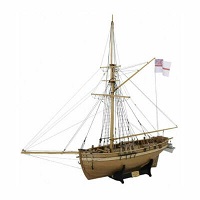 |
| Matthew Turner Brigantine | The Matthew Turner Brigantine Model Ship Kit is manufactured by Modellers Shipyard. Modellers Shipyard offer historically accurate Wooden Model Ship Kits and Wooden Model Boat kits which are faithful interpretations of the original vessels. The comprehensive instructional DVDs, plans and highly detailed English instructions will assist you throughout the whole construction process. All ship model kits are double plank on bulkhead construction and only use the highest quality parts. The main inspiration behind building Matthew Turner model ship kit was the Turner designed brigantine Galilee, launched in 1891. Galilee spent much of her career as a packet, making swift passages back and forth between San Francisco and South Sea ports. She ended her days on the Sausalito mudflats – Galilee Harbor is named for her – but her stern is preserved at Fort Mason and her stem at Benicia. This model of Matthew Turner is expertly designed with a keel and bulkhead construction. A unique feature of this kit is that it has fairing laser score lines on the bulkheads to make the fairing accurate and symmetrical. All laser cutting is clean and crisp and all parts and fittings are of the highest quality. The English building instructions provide highly detailed step-by-step descriptions supported by colour photos of the model being built. The kit is single layer planked. History of the Matthew Turner Brigantine The Matthew Turner Brigantine launched at Sausalito, California in April 2017 the brigantine Matthew Turner is the largest wooden sailing ship to be built in the San Francisco Bay Area in more than 100 years. Built of Douglas fir and Oregon white oak Matthew Turner has an overall length of 132 feet (40m), a beam of 25 feet (7.6m) and displacement of 175 tons (160 tonnes). The ship pays homage to the ship’s namesake. Matthew Turner (June 17, 1825 – February 10, 1909) was an American sea captain, shipbuilder and designer. He constructed 228 vessels, of which 154 were built in the Matthew Turner shipyard in Benicia, California. He built more sailing vessels than any other single shipbuilder in America,and can be considered “the ‘grandaddy’ of big time wooden shipbuilding on the US Pacific Coast. Scale 1 to 48 Length 34.5" (870mm) Height 27.5" (630mm) | 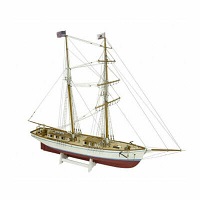 |
| Colonial Ketch Mary Byrne 1826 | The Colonial Ketch Mary Byrne 1826 Model Ship Kit is manufactured by Modellers Shipyard. Modellers Shipyard offer historically accurate Wooden Model Ship Kits and Wooden Model Boat kits which are faithful interpretations of the original vessels. The comprehensive instructional DVDs, plans and highly detailed English instructions will assist you throughout the whole construction process. The Colonial Ketch Mary Byrne model ship kit is a double plank on bulkhead construction with laser cut plywood. The kit comes complete with all timber, rigging cord, and wooden and metal fittings. All parts and fittings are of the highest quality. It Includes 46 A3 pages of full colour photos and detailed drawings. History of the Colonial Ketch Mary Byrne Ketches were river & coastal traders brought to the colonies of Australia by Europeans in the early nineteenth century that evolved into designs that suited Australian coastal & river waters. The vessels had two masts and a simple sets of sails so they could be managed by crews of three seafarers. Ketches were integral to Australia’s maritime history. They connected the city and country before the advent of road and rail. The ketch is quite manoeuvrable in light winds and with a shallow draught they were well suited to negotiate the coastal rivers to transport farm products, grain and minerals to the city and shipping goods and supplies to isolated river and coastal communities along the extended coast of east and south eastern Australia. The COLONIAL KETCH MARY BYRNE 1826 is named after a young Irish girl. In 1826 Mary Byrne was sentenced in Dublin to seven years and transported to the colony of New South Wales from Dublin. Her crime was stealing a lace handkerchief. Mary’s mother Jane appealed in writing to the local authorities to save her daughter on the grounds that she was an only child and her father was dead. This was all to no avail. Mary was transported on the Lady Rowena, which left Dublin in January 1826 and arrived in Sydney in May. The ship carried 102 females from Ireland, most transported for 7 years for minor crimes. Upon arrival in Sydney Mary was assigned to Mr Still, at Bunkers Hill as a servant. The Sydney Gazette reported that Mary had an argument with a fellow worker in the kitchen which resulted in the police being summoned. Her employer Mrs Still came to her defence saying she was a church going lass and engaged to a policeman. Mary, again, found herself in trouble when another employer refused to pay her and Mary confronted the woman demanding her wages. This time, Mary received 3 months in the Female Factory at Parramatta. There is no doubt Mary was a feisty lass, for upon sentencing Mary was heard to state that she didn’t care as she’d just have to sweep a few floors. Mary eventually set-up house in the Rocks area of Sydney with John Burke, himself a convict who was issued with a ticket of leave. John Burke was a blacksmith, by trade but did serve some time as a police officer. The 1828 census shows that Mary and John had a daughter called Margaret, but sadly there is no further evidence of her existence. In about 1832 they had a son called John, who went on to marry Mary Coe at St Mary’s church in 1856. Mary Coe too, was descended from convicts. We next hear of Mary Byrne, when she was admitted to the Sydney General Hospital in May 1842. She died soon after of Erysipelas, which was also written up in the Sydney Gazette. The government records of Mary’s autopsy state that she had a ‘visitation from God’. Mary died, a convict, when she was just 36 years of age. Mary Byrnes descendants lived in The Rocks for well over 100 years and continue to live in Australia today. Scale 1 to 48 Length 23" (590mm) Height 19" (490mm) |  |






